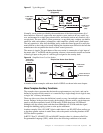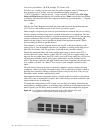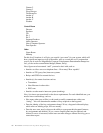
Chapter 4 - Introduction to Matrix Intercom Systems 57
input 1 --> outputs 43, 44, 45
input 3 --> output 43
program input 1 --> output 45
also inhibit the following crosspoints:
program input 1 --> output 1
Issue the following ASCII Command String to the Matrix:
IN1FI43F44F45F1IIN3FI43FINPG1FI45F
The simplified ASCII command line protocol still requires some programming to take
place external to the matrix to either translate the native language of the external control
system to Telex
®
Command Line Protocol, or to modify the internal code of the third
party device to speak and understand Command Line Protocol. This effort is likely small
when compared to the benefits of such tightly integrated control between systems. Now
that we have outlined the advantages of matrix intercom systems over other types of
systems, let’s go to the opposing viewpoint.
Disadvantages
Matrix intercom’s disadvantages over other types are pretty much the opposite of the
advantages listed above. Disadvantages include size, cost and complexity. Complexity, in
particular, renders them unsuitable for many applications.
Size
Here, size refers to not only the number of ports, but physical size as well. The smallest
physical matrix available today is the Zeus™ matrix that is two RU in height. Add in a
single RU user station and you now have a minimum of three RU of rack space required.
By contrast, Telex
®
RTS™, AudioCom
®
, and RadioCom™ intercom systems (as well
as some competitors) offer systems providing both a multi-channel user station and a
system power supply in a single RU. Matrices with larger number of ports become
correspondingly larger, physically. There are times when size is of paramount concern
such as, travel packages for news crews, remote trucks, cockpits, and Manhattan.
True Story!
One customer in NYC justified replacing their 15 year old matrix intercom with a newer
system solely on the space and power savings (electricity and cooling), going from more
than 18 racks to 2 racks of equipment and increased the number of ports in the process!
Cost
Again, somewhat related to size. If the intercom needs are small, and the complexity of
requirements are not great, the overhead of having the matrix is hard to overcome. As an
example, (2001 pricing) an intercom system with four users communicating over two
channels can be completely for less than $1,600, using a party-line system. Given the
relatively high cost of any matrix, four user stations along with a matrix would cost at least
$8,000. The matrix system would have tremendous expansion and many extra features, but
if that is not required, the cost is a definite negative factor.
Complexity
Complexity is quite often the major negative to matrix intercom systems. Complexity
brings a whole world of issues, which can be of major consequence. I’ll start with a few
examples based on our “friend” the personal computer.


















